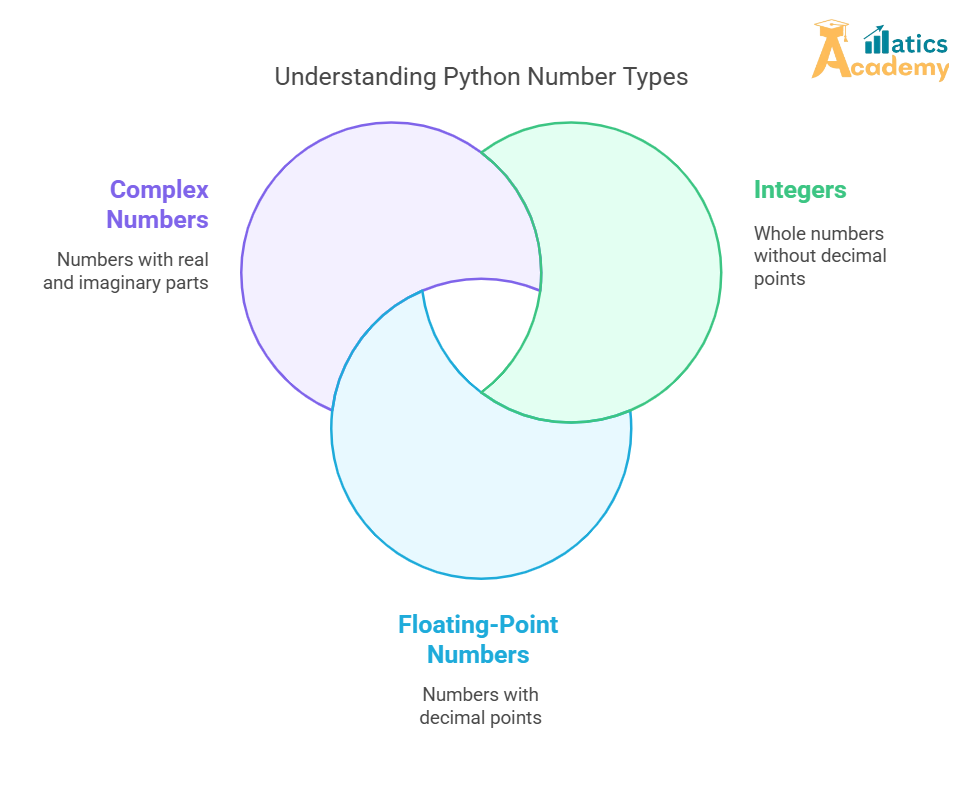Numbers are one of the most fundamental data types in Python. They are used for mathematical operations, measurements, indexing, and more. Python supports a wide range of numeric types and operations.

Table of Contents
- What Are Numbers in Python?
- Types of Numbers in Python
- Integer
- Float
- Complex
- Numeric Operations
- Type Conversion Between Numbers
- Working with Built-in Numeric Functions
- Random Numbers in Python
- Mini-Project: Basic Financial Calculator
- Common Pitfalls and Best Practices
- Interview Questions and Answers (Google, Amazon, TCS, Infosys, Zoho)
1. What Are Numbers in Python?
Numbers in Python are used to store numeric values. Python automatically determines the type of a number based on the value you assign to it.
Example:
x = 10 # Integer y = 3.14 # Float z = 2 + 3j # Complex
2. Types of Numbers in Python
Python supports three main types of numbers:
a) Integer (int)
- Whole numbers, positive or negative, without decimal points.
- Unlimited precision in Python 3.
x = 42 y = -7 print(type(x)) # Output: <class 'int'>
b) Float (float)
- Numbers with decimal points.
- Can represent real numbers and scientific notation.
x = 3.14159 y = 1.5e3 # Scientific notation (1.5 × 10³) print(type(x)) # Output: <class 'float'>
c) Complex (complex)
- Numbers with a real and imaginary part (e.g.,
a + bj).
z = 2 + 3j print(z.real) # Output: 2.0 print(z.imag) # Output: 3.0
3. Numeric Operations
Python supports a wide range of arithmetic and bitwise operations:
Arithmetic Operations
| Operator | Description | Example | Result |
|---|---|---|---|
+ | Addition | 5 + 3 | 8 |
- | Subtraction | 5 - 3 | 2 |
* | Multiplication | 5 * 3 | 15 |
/ | Division | 5 / 2 | 2.5 |
// | Floor Division | 5 // 2 | 2 |
% | Modulus (Remainder) | 5 % 2 | 1 |
** | Exponentiation | 5 ** 2 | 25 |
Example:
a = 10 b = 3 print(a + b) # Output: 13 print(a / b) # Output: 3.3333333333333335 print(a // b) # Output: 3
Bitwise Operations
Python also supports bitwise operators like &, |, ^, ~, <<, and >>.
4. Type Conversion Between Numbers
Python allows you to convert between numeric types using the following functions:
int(): Converts to integer.float(): Converts to float.complex(): Converts to complex.
Example:
x = 5.7 y = int(x) # y = 5 z = float(y) # z = 5.0 print(z) # Output: 5.0
5. Working with Built-in Numeric Functions
a) abs()
Returns the absolute value.
print(abs(-5)) # Output: 5
b) round()
Rounds a number to the nearest integer or specified decimal places.
print(round(3.14159, 2)) # Output: 3.14
c) pow()
Returns a number raised to a power.
print(pow(2, 3)) # Output: 8
d) divmod()
Returns the quotient and remainder as a tuple.
print(divmod(7, 3)) # Output: (2, 1)
6. Random Numbers in Python
The random module provides functions to generate random numbers:
random.random(): Returns a random float between 0 and 1.random.randint(a, b): Returns a random integer betweenaandb.random.choice(sequence): Picks a random item from a sequence.
Example:
import random print(random.random()) # Random float print(random.randint(1, 10)) # Random integer between 1 and 10
7. Mini-Project: Basic Financial Calculator
Objective:
Create a calculator that computes compound interest based on user input.
# Financial Calculator
def calculate_compound_interest(principal, rate, time):
amount = principal * (1 + rate / 100) ** time
interest = amount - principal
return interest, amount
# User input
principal = float(input("Enter the principal amount: "))
rate = float(input("Enter the annual interest rate (%): "))
time = float(input("Enter the time (years): "))
interest, total_amount = calculate_compound_interest(principal, rate, time)
print(f"Compound Interest: {interest:.2f}")
print(f"Total Amount: {total_amount:.2f}")
Sample Output:
Enter the principal amount: 1000
Enter the annual interest rate (%): 5
Enter the time (years): 2
Compound Interest: 102.50
Total Amount: 1102.50
8. Common Pitfalls and Best Practices
Pitfall 1: Division by Zero
- Issue: Attempting to divide by zero causes a runtime error.
- Solution: Always validate divisor values before performing division.
Pitfall 2: Precision Errors with Floating-Point Numbers
- Issue: Floating-point arithmetic may result in slight precision errors.
- Solution: Use the
decimalmodule for high-precision calculations.
Interview Questions and Answers
Q: What is the difference between // and / in Python?
A: / performs regular division and returns a float, while // performs floor division and returns an integer (or float if one operand is a float).
print(5 / 2) # Output: 2.5 print(5 // 2) # Output: 2
Amazon
Q: How can you generate random numbers in Python?
A: Use the random module. For example:
import random print(random.randint(1, 10)) # Random integer between 1 and 10
TCS
Q: Write a Python program to find the sum of the digits of a number input by the user.
A:
num = int(input("Enter a number: "))
total = sum(int(digit) for digit in str(num))
print(f"Sum of digits: {total}")
Infosy
Q: How can you represent complex numbers in Python?
A: Use the complex type, with the syntax a + bj.
z = 3 + 4j print(z.real) # Output: 3.0 print(z.imag) # Output: 4.0
Zoho
Q: What will the following code output? Why?
print(0.1 + 0.2 == 0.3)
A: Output: False
Reason: Due to floating-point precision errors, 0.1 + 0.2 evaluates to 0.30000000000000004.
Conclusion
Understanding Python’s numeric types and operations is vital for data analysis, scientific computing, and financial modeling. By mastering Python’s number system, you can handle calculations efficiently and effectively.
Numbers
Question
Your answer:
Correct answer:
Your Answers
